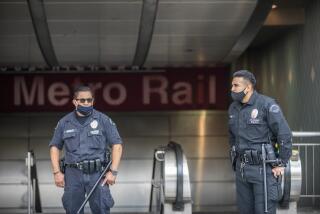Commission Kicks Caltrans’ Tires and Finds a Jalopy
California’s transportation program is antiquated, disorganized and wasteful--and not likely to improve soon because Caltrans is wedded to a history as the state’s highway department and cannot adapt to new ideas such as mass transit and locally funded highway projects.
That is the blunt conclusion of the Commission on California State Government Organization and Economy--the so-called Little Hoover Commission--which has called for the creation of a Cabinet-level agency headed by a secretary of transportation to address the problem.
Many Californian commuters endure a “Twilight Zone version of hell” every day, trapped in traffic tie-ups on the state’s “inadequate freeways and highways,” Commission Chairman Nathan Shapell told Gov. Pete Wilson and the Legislature in a letter accompanying the report.
Despite earlier Little Hoover Commission recommendations for Caltrans improvements, Shapell added, “California still staggers along with a system that lacks solid cost-benefit analyses and . . . ignores modern techniques of project management.”
The commission’s analysis was praised by Assembly Transportation Committee Chairman Richard Katz (D-Sylmar) as a “two-by-four to the skull” of government leaders in Sacramento.
Caltrans spokesman Jim Drago, however, dismissed the report as largely old news, filled with recommendations that the agency either has already implemented or has tried and rejected.
Caltrans highway construction management led the commission’s list of complaints. The report said Caltrans highway projects cost more and take longer because the agency does not assign managers to take sole responsibility for each one.
“When no one person is in charge of a project, it is too easy for finger-pointing to take the place of responsibility,” said Commissioner Barbara Stone, chairwoman of the subcommittee that wrote the report. “The results are delays and wasted funds that could better be used to ease other transportation problems.”
The independent state watchdog agency also argued that the State Transportation Improvement Plan process is unwieldy and should be radically altered, as should the historical compromises that guarantee each county and each region a fair share of state transportation money.
Commissioners said they believe this prevents prudent cost-benefit analyses, permitting the construction of dubious projects in some areas while other, urgent needs go unmet--a contention that was greeted skeptically by legislators from rural districts with the most to lose under a new formula.
“We allocate these funds not for a bunch of local problems, but to build a complete state highway system,” said state Sen. Barry Keene (D-Benicia). “That requires that we protect parts of the state that are less dense--not for benefit of those areas, but for the benefit of the entire system.”
The commission’s 66-page report, “Transportation: Keeping California Moving,” also chided the state transportation department for devoting less than 1% of its personnel to mass transit programs. The report said this lack of foresight was most apparent in the department’s failure to develop a high-speed train program, even though the corridor between the Los Angeles Basin and the San Francisco Bay Area is ideally suited to train travel.
“Our commission has concluded that a lack of leadership and inadequate planning continue to prevent the state from implementing the improvements that are needed,” Shapell said as he released the report at a news conference in Hollywood.
Drago, the Caltrans spokesman, said his agency until recently was limited in what it could do with state and federal transportation funds because most of the money was strictly limited to highway improvements. He said that has changed with the passage of state and federal laws that allow Caltrans flexibility in the spending of transportation funds.
“With flexibility now built into both state and federal funding,” said Drago, “we can take money that once would have been set aside exclusively for, say, adding lanes to the Harbor Freeway, and we can look to see if it makes more sense to build (car-pool) lanes or extend light-rail lines.
“We’re committed to being a real transportation agency,” he added.
Stone, however, said mass transit projects have been stymied primarily by the absence of administrative support. For that reason, she said, it is important for the state to split a new transportation agency out of the existing business, transportation and housing agency.
More to Read
Sign up for Essential California
The most important California stories and recommendations in your inbox every morning.
You may occasionally receive promotional content from the Los Angeles Times.









